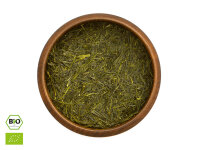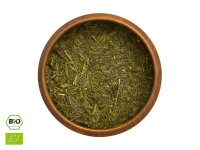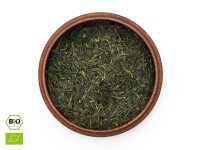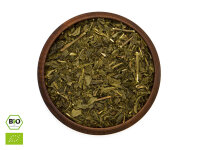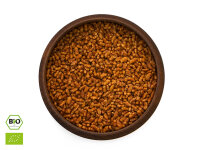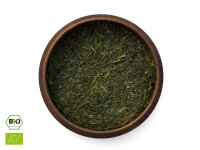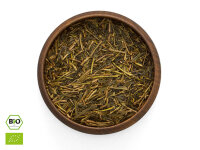
Kabusecha Tea
Kabusecha Tea – A Popular Shade-Grown Tea from Japan
Kabusecha is one of the finest teas in Japan. It is semi-shaded, which means the shading period is significantly shorter, around 7 - 14 days, compared to Gyokuro. This unique method results in a green tea that combines the health and flavor characteristics of Sencha (unshaded) and Gyokuro (shaded) in a positive way. Kabuse, in Japanese, simply means "to cover," but unlike Gyokuro, only individual tea bushes are covered, not the entire field.
The shading process slows down the growth of the tea plant and reduces the production of catechins. Selected varieties of this tea often offer a lot of umami and only a few, subtle bitter compounds (Nigami), combined with a slight astringency (Shibumi). Intensive, dark green leaves are also an indicator of the tea's quality.
Kabusecha fills the gap between mild Sencha and flavorful Gyokuro. Its post-harvest processing is identical to the aforementioned varieties. Rapid but gentle processing after harvesting is a crucial criterion for quality. After plucking, the leaves are lightly steamed to halt the oxidation process. Steaming often lasts only between 10 and 40 seconds. After steaming, the leaves are rolled, which slightly breaks the leaf structure, allowing the components to be absorbed well by the tea-water. Finally, the green tea is packaged in an airtight manner.
The Effects of Kabusecha Tea on Health
Like almost all Japanese green teas, Kabusecha contains numerous ingredients for a healthy impact. These include protective antioxidants / catechins (EGCG), and especially the amino acid L-Theanine, which promotes well-being, balance, and relaxation, as well as various vitamins (Vitamin A Beta Carotene, Vitamin B1, B2, B3, Vitamin E, and Vitamin K).
For the full health benefits, we recommend alternating between different green teas. This way, you benefit from the different focuses of active ingredients from the respective green tea varieties. Green tea can be enjoyed daily without hesitation.
High-Quality Kabusecha at ORYOKI
The effort involved in cultivating Kabusecha is somewhat lower than that for Gyokuro. Since the tea is very close in quality and taste to top-quality tea, it is often a welcome alternative at a good price. For our selection, we took our time and compared many Kabusecha from different regions and growing areas in the Land of the Rising Sun. The combination of quality, organic cultivation, and excellent taste was the benchmark we used.
- Kabusecha Asuka, Organic »
- KEIKO Kabusecha Tenbu Fuka, Organic »
- KEIKO Kabusecha Soshun, Organic »
- KEIKO Kabusecha Dan, Organic »
- KEIKO Kabuse Houjicha, Organic »
- KEIKO Aki-Benifuuki, Organic »
Currently, we are testing other selected varieties from Japan, some of which will soon complement our green tea assortment.
The "Right" Preparation of Kabusecha Green Tea
There is no universally valid rule for preparation. However, there are always guidelines to extract the full flavor from green tea. The recommendation varies slightly from one variety to another. For dosing, we recommend about two teaspoons of Kabusecha for 150 ml of water. Boiling water should be cooled to approximately 55 - 65 °C. The steeping time for the first infusion is between 1 - 2 minutes. Make sure the tea leaves have opened. Steeping for too long can release many usually unpleasant bitter compounds from the tea, which are not desired. For the second and third infusions, the steeping time is significantly shorter, about 15 seconds each.
However, even with slight variations in tea preparation, the taste can be influenced in one direction or the other. With a little experimentation, the tea can be tailored to your own taste. We recommend slight variations in water temperature in 5 °C increments and slightly shorter or longer steeping times.
For the full tea experience, we recommend consuming green tea as soon as possible after opening the package. Otherwise, green tea quickly loses its flavor.





Enjoying Kabusecha Tea, Just Like in Japan
For tea lovers, especially those for whom green tea plays a significant role, the question of which teapot offers the best tea experience arises relatively quickly. For high-quality green teas, the original clay teapot (Kyusu) is traditionally the perfect choice. The Yokode Kyusu, a side-handled teapot, is the most commonly used. In our assortment, you will find a good selection of handcrafted side-handled pots by Japanese masters.
Porcelain teapots, a good and beautiful material for this purpose, are also used in Japan. They are often handcrafted using traditional manufacturing methods. We also offer such porcelain teapots made in Japan. Our green tea pot So-So has received design awards and is a highly decorative representative of the porcelain teapot category. Here, the porcelain is very high-quality, thin, and slightly transparent.
The black cast iron teapots Arare and Hira Arare impress with their style and appearance. Especially important for health: When making a purchase, always ensure that you are getting originals. Poor copies at low prices are unfortunately common, but the iron in these pots is usually not conducive to health!

